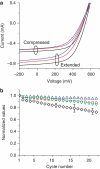Ultrathin and lightweight organic solar cells with high flexibility
- PMID: 22473014
- PMCID: PMC3337988
- DOI: 10.1038/ncomms1772
Ultrathin and lightweight organic solar cells with high flexibility
Abstract
Application-specific requirements for future lighting, displays and photovoltaics will include large-area, low-weight and mechanical resilience for dual-purpose uses such as electronic skin, textiles and surface conforming foils. Here we demonstrate polymer-based photovoltaic devices on plastic foil substrates less than 2 μm thick, with equal power conversion efficiency to their glass-based counterparts. They can reversibly withstand extreme mechanical deformation and have unprecedented solar cell-specific weight. Instead of a single bend, we form a random network of folds within the device area. The processing methods are standard, so the same weight and flexibility should be achievable in light emitting diodes, capacitors and transistors to fully realize ultrathin organic electronics. These ultrathin organic solar cells are over ten times thinner, lighter and more flexible than any other solar cell of any technology to date.
Figures







References
-
- Lipomi D. J. & Bao Z. Stretchable, elastic materials and devices for solar energy conversion. Energy Environ. Sci. 4, 3314–3328 (2011).
-
- Baca A. J. et al.. Compact monocrystalline silicon solar modules with high voltage outputs and mechanically flexible designs. Energy Environ. Sci. 3, 208–211 (2010).
-
- Brabec C. J., Sariciftci N. S. & Hummelen J. C. Plastic solar cells. Adv. Funct. Mater. 11, 15–26 (2001).
-
- Coakley K. M. & McGehee M. D. Conjugated polymer photovoltaic cells. Chem. Mater. 16, 4533–4542 (2004).
-
- Hauch J. A. et al.. Flexible organic P3HT:PCBM bulk-heterojunction modules with more than 1 year outdoor lifetime. Sol. Energ. Mat. Sol. C 92, 727–731 (2008).
Publication types
LinkOut - more resources
Full Text Sources
Other Literature Sources

